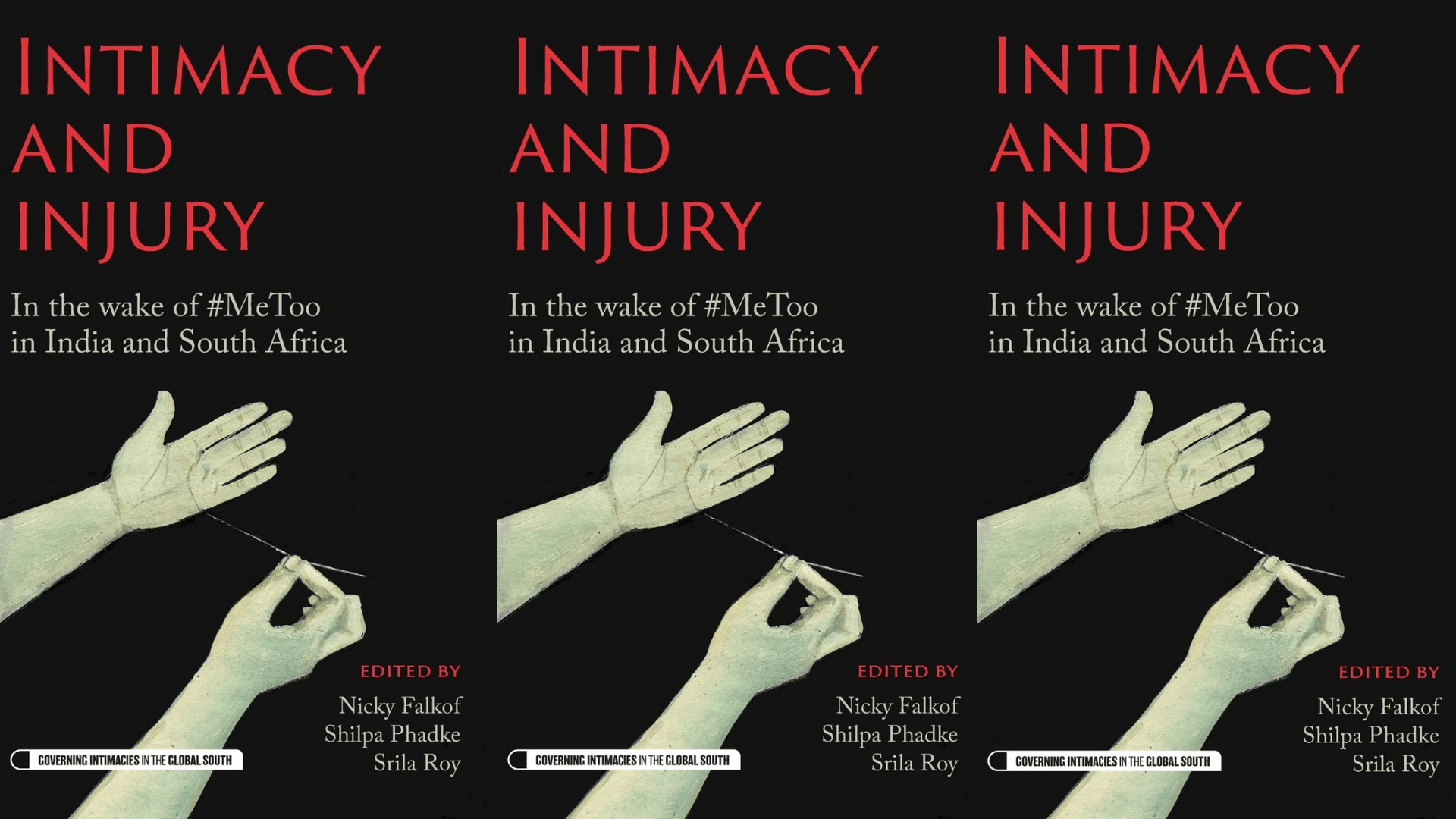A vehement plea for a gender just future forms the bedrock of this anthology that covers a wide spectrum of unresolved socio-cultural issues. From discussing the politics of the #MeToo movement; gender-based violence (GBV) against sexual minorities; normalisation of victim-shaming in a society where rape culture, femicide, casteism, and racism are ubiquitous, to deconstructing heteronormative socio-legal approaches to gender-blind media discourses on GBV and related crimes in rural and urban spaces, Intimacy and Injury: In the wake of #MeToo in India and South Africa (edited by Nicky Falkof, Shilpa Phadke, and Srila Roy; Manchester University Press, May 2022) is a pathbreaking work in its imperative intent, meticulous conceptualisation, and immaculate execution.
Being intersectional
As their tools of critical analysis, the contributors have relied on intersectionality, transnationalism, inclusivity, and reflexivity in their exploration of the landscape of violence and violation in India and South Africa. In the introduction, the editors remind us that “there can be no feminist resistance – no #MeToo – that is not intersectional.”
As their tools of critical analysis, the contributors have relied on intersectionality, transnationalism, inclusivity, and reflexivity in their exploration of the landscape of violence and violation in India and South Africa. In the introduction, the editors remind us that “there can be no feminist resistance – no #MeToo – that is not intersectional.”
The silences and pauses that are often either dismissed within the positivist paradigm of research or conveniently erased and rejected by a majoritarian, androcentric, white supremacist, heteronormative ideology that upholds the tenets of ‘objectivity’ and ‘value-neutrality’, find a credible voice and space in this book.
The birth of the #MeToo movement and the way it evolved in India and South Africa has been examined through a feminist ‘gaze’ while navigating and negotiating through the lanes of optimism and scepticism in an age of what the editors of the book call “clicktivism”.
‘Southern lives’ matter
The book is divided into thematic clusters. The initial segments put into perspective the historical context of the global movements of resistance against gendered violence through conversations, debates, and dialogues based in India and South Africa. With #MeToo at the centre of these discussions emerging out of the global south, various crucial yet neglected concerns regarding institutional failure, structural and legal apathy in addressing questions of agency and choice of the marginalised (on the basis of class, caste, race, colour, and sexuality) assume prominence from the analytic lens of ethnography.
The silences and pauses that are often either dismissed within the positivist paradigm of research or conveniently erased and rejected by a majoritarian, androcentric, white supremacist, heteronormative ideology that upholds the tenets of ‘objectivity’ and ‘value-neutrality’, find a credible voice and space in this book.
As part of its feminist agenda, this book establishes the geographical identity and validates the first-hand experiences of the contributors, who are committed to turning the spotlight on the subjectivities of the unheard and the voiceless (Dalits, queer, rural women working class, racial minorities) — otherwise considered ‘unremarkable’ by the Western gaze and canon. It marks an epistemic shift in the ‘universal’ and stereotypical perception of sexual violence by prompting an interdisciplinary, transformative, and hermeneutical engagement with the politics of representation of the “southern lives” to discover newer, more inclusive ways of enquiry and research.
‘Personal is political’
The second half of the book delves into the layered meanings of the dictum “personal is political” by scrutinising power relations, dynamics of desire, and sexual autonomy through in-depth interviews, first-hand accounts, and reflections of those who are stigmatised and find themselves at the receiving end of “contemporary crises of GBV in India and South Africa”.
The second half of the book delves into the layered meanings of the dictum “personal is political” by scrutinising power relations, dynamics of desire, and sexual autonomy through in-depth interviews, first-hand accounts, and reflections of those who are stigmatised and find themselves at the receiving end of “contemporary crises of GBV in India and South Africa”.
Enmeshed in a complex web of legal parlance that often confuses between what is consent and how to understand coercion, the embedded and embodied realities of the survivors of abuse and assault occupy centre stage in this timely anthology, which was in its embryonic stage in 2019 during a workshop at Wits University that brought together feminist scholars from India and South Africa under one roof.
Sisterhood and solidarity: same or different?
Instead of being engaged in an endeavour to capitalise on commonalities and “forced” sameness, it could be liberating to weave diversity into the framework of feminist philosophy to bring about necessary socio-political change. In prioritising heterogeneity over the limitedness of ‘homogenous’ and ‘shared’ realities, the difference between the ‘universal’ notion of sisterhood and an ‘intersectional’ understanding of feminist solidarity becomes clear.
Gender-based oppression too, therefore, cannot be a ‘unified’ experience. In her 1986 essay, ‘Sisterhood: Political Solidarity between Women’, bell hooks explains the need to unlearn the concept of sisterhood as proposed by “white bourgeois women liberationists”. She asserts, “The vision of sisterhood evoked by women’s liberationists was based on the idea of common oppression. Therefore, in order to achieve sustainability in the envisioning of a feminist future, there must be a shift from the “insistence on ‘common oppression'” to “solidarity (that) strengthens resistance struggle” (hooks, 1986). And that solidarity must be premised on varied realities, complexities, and a polyphony of voices, as endorsed by the contributors in Intimacy and Injury.
An ‘ideal’ victim
In one of her lectures – later published as an essay titled, ‘Violence, Mourning, Politics’ (2002) – Judith Butler discusses the politics of grief and vulnerability in terms of “what makes for a grievable life” and whether a ‘hierarchical’ framework of grief excludes gender minority groups from being considered ‘human’ enough. The resonances of this line of argument are reflected in the first part of Intimacy and Injury, which brings to focus three seminal femicide cases — one in India and two in South Africa — by examining the media narratives and public responses that emerged in 2012–13.
The author also sheds light on how the media can dictate “whose bodies matter” or who is a “legitimate victim”, thereby bringing us back to Butler’s theory of whose life gets counted and whose loss is ‘adequately’ mourned.
The ‘rape-homicide’ of Jyoti Singh (Nirbhaya) in Delhi in December 2012, Anene Booysen in Bredasdorp, South Africa in February 2013, and the killing of South African model Reeva Steenkamp weeks after Booysen’s death led to significant revelations.
Author Nechama Brodie raises a pertinent point about what constitutes a ‘real’ rape. Brodie argues, “…any sexual assault that is neither deadly nor extremely violent – thus leaving the affected woman at the verge of death – runs the risk of not being considered a ‘real’ rape. Surviving almost suggests the victim is complicit in her own rape.”
It must also be noted that the Nirbhaya case provided a template or a ‘framework’ for the South African media to construct Booysen’s death in an ‘extraordinary’ way, which otherwise would have been dismissed as a ‘local’ ‘ordinary’ case in a country whose femicide rate is “more than six times the world average”. This kind of normalisation and naturalisation of violence must be challenged.
The author also sheds light on how the media can dictate “whose bodies matter” or who is a “legitimate victim”, thereby bringing us back to Butler’s theory of whose life gets counted and whose loss is ‘adequately’ mourned.
Similarly, Jamil F. Khan’s searing reflection piece, ‘Gay Boys Don’t Cry When We’re Raped’, offers a critical look at the way queerness is invariably associated with shame, secrecy, and stigma. The fact that gender non-conforming individuals are outside of what Gayle Rubin calls the ‘Charmed Circle‘ of compulsory heterosexuality and sexual hierarchy makes them suffer from self-recrimination. Khan observes, “I had never seen an example of queer sex, normalised and acceptable as a form of pleasure.” Yet again, Butler’s argument about who is worthier, acceptable, and normal rings true.
Sex work and the ‘right to dignity’
The recent Supreme Court ruling (May 19, 2022) recognised that sex workers are “entitled to dignity” and “equal protection of the law”. The three-judge Bench headed by Justice L. Nageswara Rao added, “When it is clear that the sex worker is an adult and is participating with consent, the police must refrain from interfering or taking any criminal action.” While the move has been celebrated by many, the fact of the matter remains, as pointed out by activists, that the legal right of a sex worker continues to be “ambiguous”.
Prostitution as an institution is still illegal; as one of the SC recommendations clarifies, “running a brothel is unlawful”. Therefore, the precarity of the profession is intact. Sex workers may have gained a semblance of rights, but the sex trade has not. In this context, the conversation between Ntokozo Yingwana and Nosipho Vidima on the #SayHerName campaign in this anthology is an important intervention in the longstanding debate on the recognition of human rights, constitutional protection, and legal entitlement of consenting sex workers.
Also read: The Contributions Of The #MeToo Movement To The Discourse On Sexual Violence
Miles to go
Whether it is about exploring the nuances, complexities, and shortcomings of digital feminism(s) in the global south, the integration of feminist care ethics in (de)/(re)constructing queer narratives, Dalit-Bahujan struggles, or the prioritisation of affirmative action and affective activism in pushing the marginal to the centre, this anthology holds up a mirror to society and bears testimony to the countless battles that are yet to be won before we can actually walk on the road leading to empowerment, emancipation, and egalitarianism.
Intimacy and Injury is a stark reminder that though we are miles away from where we ought to be, we must nonetheless continue to strive and thrive for a better and more equitable future.
Also read: Me Too At The Margins: Women, Trauma And Testimonies
Featured Image Source: Amazon, Governing Intimacies, TISS
About the author(s)
With over 10 years’ experience in publishing and journalism, Ipshita Mitra has a Bachelor’s degree in English Literature from Miranda House, DU and holds a PG Diploma in English Journalism from IIMC. She did her MA in Gender and Development Studies and is currently pursuing her PhD in Gender Studies from IGNOU.
She has worked with The Times of India, The Asian Age, The Quint, Om Books International, World Monuments Fund India Association, and The Energy and Resources Institute (TERI). In 2016, her short story ‘Cacophony of Silence’ was published by Nikkei Voice, a Canadian-Japanese newspaper. In 2020, her short story ‘Bohemian Sailor of the Gulf’ was published by Sublunary Editions, a Seattle-based independent publisher. The Indian Quarterly (April–June 2021) published her short fiction, ‘Kabuliwala Returns’. She writes on books, culture, environment, and gender for TerraGreen, The Hindu, Scroll.in, The Wire, Wasafiri, Firstpost, Huffington Post, India Currents, and others. She tweets @ipshita77.





